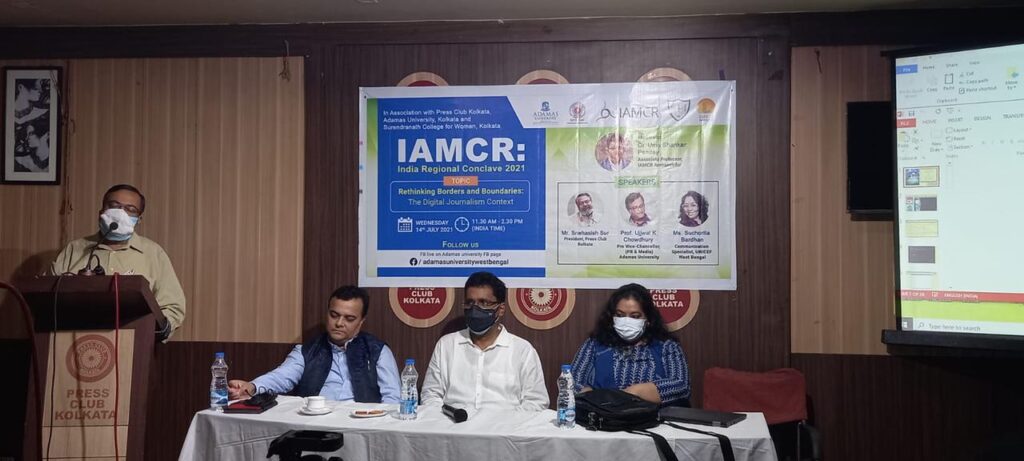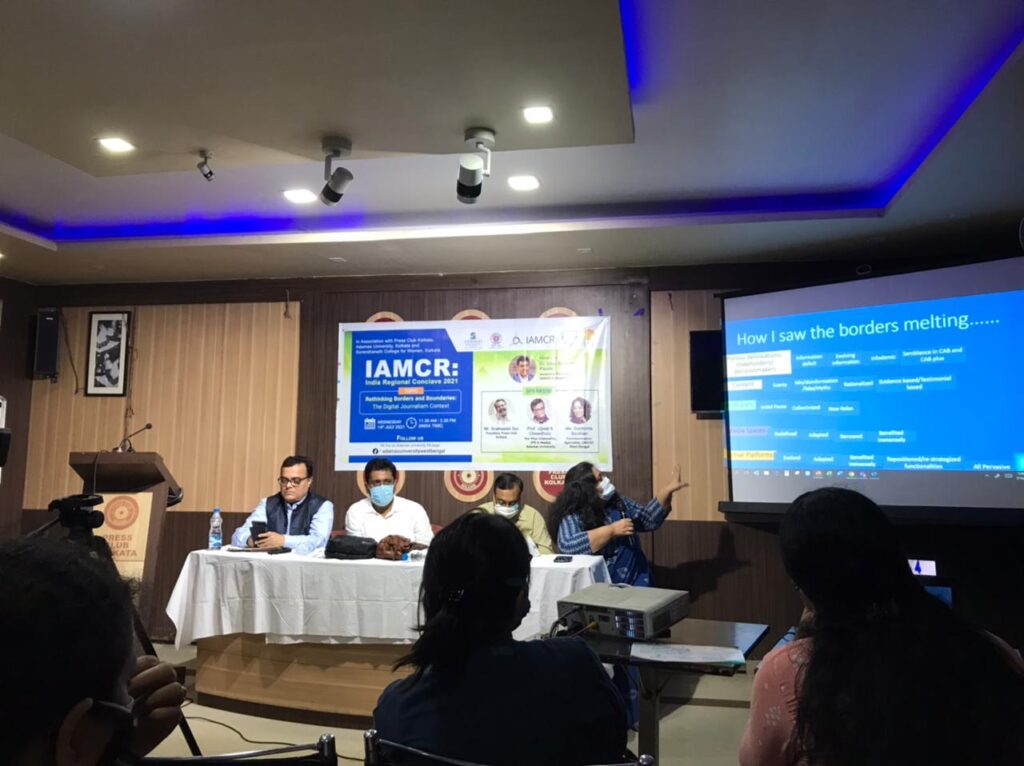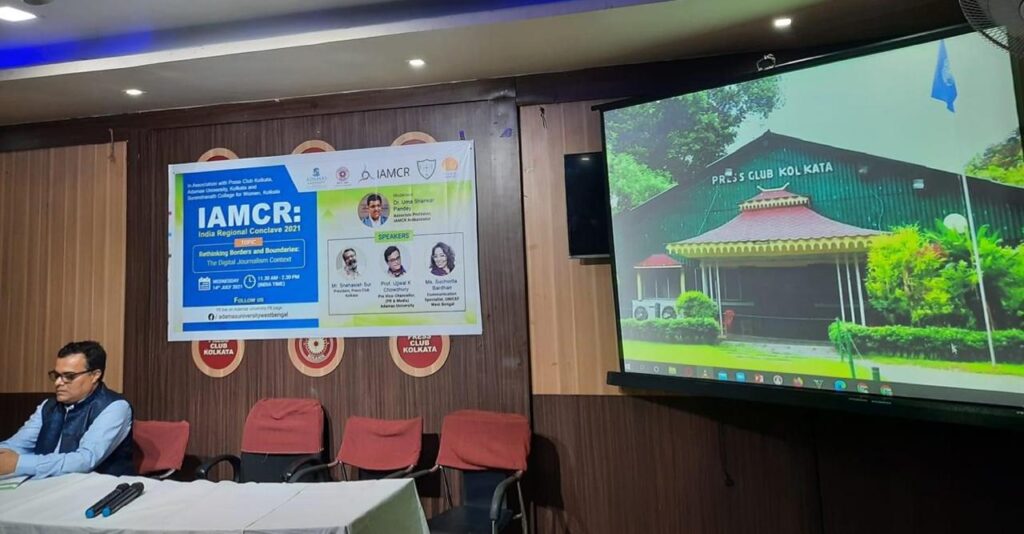The IAMCR-India Regional Conclave on ‘Rethinking Borders and Boundaries: The Digital Journalism Context’ organized as part of the IAMCR 2021 No Travel Event was attended by over 25 academicians from different colleges and universities in Kolkata and its surroundings. The offline conclave was held at the Press Club, Kolkata — the oldest Press Club in South Asia. It was organized by IAMCR-India in association with the Press Club Kolkata, Adamas University, and Surendra Nath College for Women. Dr. Uma Shankar Pandey, IAMCR India Ambassador moderated the conclave which had Shri Snehasish Sur, President, Press Club, Kolkata, Prof. Ujjwal K. Chowdhury, Pro Vice- Chancellor, (PR & Media), Adamas University, and Ms. Suchorita Bardhan, Communication Specialist, UNICEF office for West Bengal as eminent speakers. All the participants were provided certificates at the end of the conclave. The conclave was streamed live on IAMCR-India Facebook page.
Mr. Snehasis Sur, the President of the Press Club and an eminent journalist shed light on the Digital News Report 2021 and E&Y FICCI report on the media and entertainment sector. Presenting interesting facts pertaining to highlight the growth of digital media, he reiterated, “Covid 19 has negatively impacted the media industry. However, if one goes across the reports and data, it can we witnessed that the trajectory of the growth of Digital and New Media is rising.”
He also explained, “Digital media and the animation and gaming industry are those fragments of the media industry which have shown a whooping growth in the last few years. Digital is sans borders. Today, in a country like India where Digital divide is so prominent, one still needs to get registered on CoWIN platform for getting vaccinated.”

Mr. Sur was of the opinion that the works of Marshal MacLuhan are unparalleled in the field of Digital Journalism. He added, “OTT is the delivery mechanism of the future, soon television sets will be extinct and the content access device will be smartphones.” He also attracted the attention of the audiences to the grave problem of misinformation in social/digital media and voiced the need of a digital policy.
Ms. Suchorita Bardhan, the Communication Specialist at UNICEF India, has worked extensively in activities which require communication for development to bring a social change in the society. She at length discussed the topic of Risk Communication and Reporting. She articulated, “The social media has an important role in spreading information and awareness. Social media has created content producers out of the audience. Every person today is empowered to contribute to content making, all because of the social media. Sometimes, there are such stories which are often ignored by the mainstream media. But later when such stories are shared on social media and they become viral, the popular media organisations pick them up and run it. Such is the power, which social media has.”

She acquainted the audience with the role of digital in the lives of the ordinary people to bring about development. Shedding light on the various projects she has been associated with particularly for the progress of the younger generation, she reiterated, “Local is the next global”. Ms. Bardhan also acquainted the audience about her E-Dasham Experiment where children were tasked with picking up stories and producing the content.
Prof. Ujjwal K. Chowdhury, Pro Vice- Chancellor, (PR & Media), Adamas University, spoke mostly on the significance of mobile journalism. He discussed at length about mobile journalism and gave critical perspectives upon mobile journalism and explained the spere of mobile journalism. According to him, mobile as a small device do have the potential to take the content to anywhere. He acquainted the audiences with the role of mobile in journalism. According to him, mobile-first will be the new mantra of the news media of the future.
“Stories from the hinterland is possible with the help of mobile journalism’, he added. He also stressed on the inclusion of media literacy and mobile journalism course in the curriculum for media students. The Curriculum should focus on creating awareness on what type of media to be consumed and how, and how to identify and avoid false and fake news. This is an urgent need of the day, he continued. He signed off his lecture by playing a video on mobile journalism for the attendees.

The conclave started with the opening remarks by Dr. Uma Shankar Pandey, IAMCR Ambassador of India. In his opening remarks, he stressed on the theme of “Rethinking Borders and Boundaries: The Digital Journalism Context” and also articulated the major thrust areas of this conclave.
‘The IAMCR regional conclave illuminated the minds of many by bringing forth the opportunity for discussion among the illuminati from the sphere of media and communication’, said Arijit Ghosh one of the participants.
Talking about the growth of Digital Journalism, Dr. Uma Shankar Pandey said, “Digital Journalism has been taken in a big way, it has though taken a long time to be adapted by people. But the pandemic has further led to the acceleration of the absorption of the practice of Digital Journalism. Online journalism is here to stay.”
